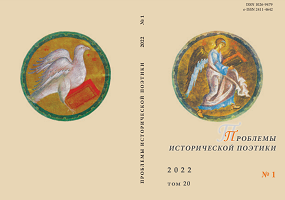Архетипический сюжет инициации в рассказе В. П. Астафьева «Далекая и близкая сказка»
Archetypal Plot in the “The Faraway and Nearby Tale,” a Short Story by V. P. Astafyev
Author(s): Guzel M. IbatullinaSubject(s): Customs / Folklore, Semantics, Russian Literature, Culture and social structure
Published by: Петрозаводский государственный университет
Keywords: V. P. Astafyev; “The Last Tribute”; “The Faraway and Nearby Tale”; folklore tradition; fairy tale; archetype; plot; initiation; myth; symbol; context;
Summary/Abstract: The article is devoted to the study of the archetypal plot basis of V. P. Astafyev’s short story “The Faraway and Nearby Tale.” The reconstruction of the figurative and semantic paradigms of a fairy tale in the work allows to see that the reference to folklore contexts is not merely declared here as a metaphor for the spiritual and psychological states experienced by the character, but determines the logic of his development and the events that occur to him. The initiation archetype with its key plot-forming elements is interpreted in the mythologized paradigm of the short story as the boy’s journey to the “world of the dead,” which resulted in his acquisition of a radically new worldview. Instead of a perception based on duality, antitheses and the fears they generated, the character gets a sense of a deep ambivalent “unity of opposites” of different existential spheres and worlds: the real and the otherworldly, the living and the dead, the homeland and the foreign land. The motif complexes associated with this journey are reflected at different levels of the narrative’s artistic organization principles: in the system of chronotopes that perform a world-modeling function, at the level of the figurative and symbolic subtext, and in the contexts of its spiritual and moral problems. At the same time, the visual logic of Astafyev’s “fairy tale” reveals modifications and inversions of universal mythopoetic schemes, including those in the structure of the initiation plot itself, which, unlike a folk tale, acquires a prolonged and duplicated character. In this context, archetypal models enter into dialogical relations with their own event-actualized plot of the story, and exist in the system of the author’s consciousness in figurative and semantic mutual projections with the cultural space as a whole.
Journal: Проблемы исторической поэтики
- Issue Year: 20/2022
- Issue No: 1
- Page Range: 339-359
- Page Count: 21
- Language: Russian

